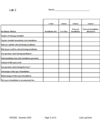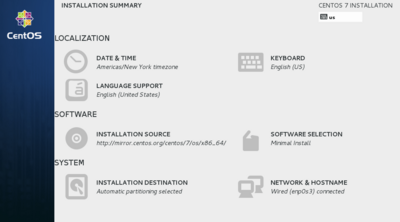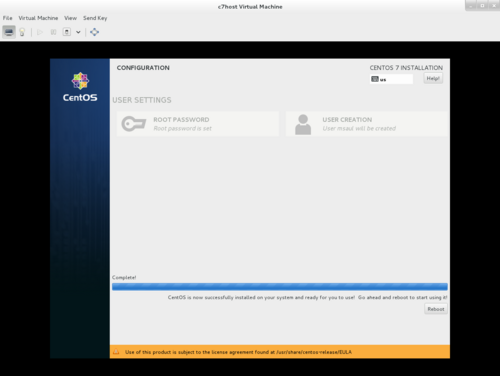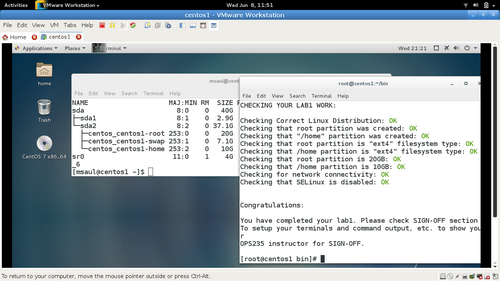OPS235 Lab 1 - CentOS7
Contents
LAB PREPARATION
Purpose / Objectives of Lab 1
You need to install a Linux OS to be a host or "platform" to install and use other Linux VMs (Virtual Machines) during this course.
The Linux OS you will be installing in this lab will be a Host Machine (hostname: c7host) that will allow you to run Virtualization Software to create 3 separate virtual machines (to be performed in lab2). It is important to install this host machine correctly since other labs will depend on the stability of this host machine.
Main objectives:
- Correctly install the CentOS 7 FULL INSTALL DVD (not LIVE DVD) on your removable hard disk.
- Record installation characteristics of CentOS 7 FULL INSTALL in a chart (contained in lab2 logbook chart) to compare with other installation methods performed in lab2.
- Verify correct settings prior to proceeding with host installation stages.
- Obtain Linux server information after installation to create a software asset report for later access.
- Disable Linux Kernel security enhancements to allow easier internal networking connections (to be reactivated in a later lab).
- Observe that Bash Shell Scripts can automate routine tasks.
Minimum Required Materials
My Toolkit (CLI Reference)
| Package Management | System Information | Networking | Miscellaneous
grep
|
INVESTIGATION 1: CREATE HOST MACHINE (c7host)
For the next 3 investigations, you will learn how to install your Centos Full DVD onto your removable hard disk. You will customize your install to setup several separate partitions: root (/), /home, /var/lib/libvirt/images (to store virtual machine images to be created in lab2), and a swap partition. Make certain to record your observations of this install in the comparison chart for c7host in your lab2 logbook.
Part 1: Start Installation
- Host Machine Details:
- Name: c7host
- Boot media / Installation: CentOS7 Full Install DVD
- Memory: 16GB
- Disk space: 250GB (or higher)
- CPUs: 1
- Refer to this listing of installation screenshots if you need a reference:
[ installation screenshots ] - Insert your removable SATA hard disk into the drive tray.
- Set your computer's drive selector switch to external (a.k.a position #4).
- Power up the computer and insert the CentOS 7 Installation DVD into the DVD drive, then power-off computer.
- Restart the computer, and press the function key F10, press ENTER, and specify the device to boot (eg. DVD drive).
- NOTE: Refer to the comparison chart in lab2 lab logbook, and fill in various installation information for c7host while you perform the installation (such as time it took to perform a full install, installation options, etc).
- Select the option Test this Media & Install Centos7. Your DVD will be checked for defects
- If the check is successful, you will be prompted for a language. In the first screen, select language English with subselection English-Canada and then click the Continue button on the bottom right-hand screen.
- The Install Summary should now appear. This screen allows the installer to customize their Centos7 system prior to installation.
- Configure the following installation settings from the Install Summary Screen:
DATE & TIME:- Click on the Map to select Toronto area (you may also select from the drop-down menu section)
- Click the DONE button at the top-right corner to finish and return to the Installation Summary screen.
NETWORK & HOSTNAME:- Select the default Ethernet connection and click the button on the right-hand side to change the setting from OFF to ON.
- At the bottom right-hand corner type the hostname: c7host (all lowercase letters)
- Review your settings, then click the DONE button at the top-right corner to finish and return to the Installation Summary screen.
SOFTWARE SELECTION:- Select the software packages labelled: Gnome Desktop
- Click the DONE button at the top-right corner to finish and return to the Installation Summary screen.
- Although the Centos installtion program can provide suggestions on how to partition your hard disk, you will be customizing partitions for your hard disk. This custom partitioning is important since it will have consequences on future labs that you perform (especially lab2!).
Part 2: Custom Partitioning
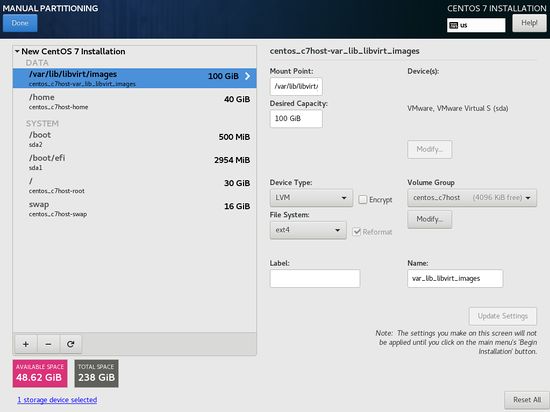 Carefully verify partition mount-names and sizes prior to proceeding with install. Check installation screenshots link for verification. |
- From the installation summary screen, click Installation Destination.
- In the installation destination screen, select the destination option: I will configure partitioning and then click Done.
- The manual partitioning screen should appear. Change the option New mount points will use the following partition scheme from LVM to Standard Partition (you will not be using LVM for your c7host machine).
- If you have used your hard disk for previous Linux (Centos) distributions, you should remove them. Click on the distribution, and for each partition, select the partition and click the remove button (minus sign) and confirm deletion.
- It is recommended to rescan the hard disks by clicking on the rescan button (loop symbol).
- Before you proceed with creating partitions, let's see the partitions that we need to create for our host computer:
- Primary Partitions (ext4):
- 30GB for / (i.e. "root")
- 40GB for /home
- 100GB for /var/lib/libvirt/images
- Swap Partition:
- 16GB (Note: "swap" must be selected from the drop down menu)
NOTE: Remember that the sizes are recorded in MB (eg. 30 GB = 30000 MB) and you should multiply GB by a factor of 1024 to get the correct size.
(eg. 30 GB x 1024 = 30720 MB) - Primary Partitions (ext4):
- We will now create the root (/) partition. Click on the add button (plus) sign.
- In the Add a New Mount Point screen, enter / as the mount-point (either by typing or selecting from drop-down menu), and enter 30720 in for partition size and click Add Mount Point button.
- Repeat the same steps above for the /home partition and /var/lib/libvirt/images partition. You need to type the /var/lib/libvirt/images partition since it does not appear in the drop-down menu.
- Select each of the created partitions, and make certain that the file-system type is changed from xfs to ext4.
- Check that your partition settings are correct (you can ask your instructor or lab monitor to confirm), and then click Done to proceed.
- A Summary of Changes screen will appear to show the partitioning operations that will be created. Click the Accept Changes button to proceed with the installation.
Part 3: Completing the Installation
- During the installation process, you will required to create a root password (for administration access) and create a regular user account. Click on Root Password and enter your root password. Think of an appropriate password and record that password somewhere in case you forget! An indicator will appear to show you how secure your password is. Retype your root password and click Done (you may have to click Done twice if your password is strong).
- You need to create a regular user account. This account will be used to graphical log into your host machine. It is never recommended to graphically log into a graphical Linux/Unix system as root. It is better to log into a regualr user account, then run a command to login as root (you will learn how to do this later in this lab.
- Click User Creation and enter your full name, username, and an appropriate password (and confirm password). Click Done to finish.
- Remember to record this host installation information in the comparison chart in lab2.
- When installation is complete, you will notice a message at the bottom of the screen stating: CentOS is now successfully installed and ready for you to use!
- Click the Reboot button. Your DVD will briefly open in the DVD drive bay. Make certain to remove this installation DVD so that Centos will boot from your hard drive.
- After the system reboots, login by clicking on your account name and entering the regular user password.
- The last phase of the installation process should now run:
- Click Accept to confirm you will abide by the License and click Done.
- Accept defaults to participate running KDump application that will report errors to developers for improvements to Centos7.
- Select English as the default input source.
- Quickly view Getting Started Resources, then close the help window.
- Proceed to Investigation 2 to obtain basic information from your newly installed Centos Host machine.
Answer Investigation 1 observations (all parts and questions) in your lab log book.
INVESTIGATION 2: OBTAINING HOST MACHINE SYSTEM INFORMATION
Part 1: Obtaining Package Management / Package Information
Navigate through your Graphical CentOS system, locate and run a terminal program (in order to issue Linux commands). Issue and record the commands used and the output generated in each of the following steps:
- Issue the following Linux command:
login root - Issue a Linux command (learned in ULI101) to confirm the type of account you are currently using. What is the purpose of this account?
- Exit your current account. Which account are you now using?
- Refer to the Information box regarding how to access the admin account from the command line.
- Issue the command
suIssue the pwd and whoami commands to confirm your directory pathname. When finished logout of this account. - Issue the command
su -Issue the pwd and whoami commands to confirm your directory pathname. Remain in this account for the remainder of this lab. - An installation log file called
/var/log/anaconda/anaconda.packaging.loghas been created to record the installation of your c7host machine. This file is an ASCII file which can be viewed with themorecommand. - You can make use of this file to determine how many packages have been installed: complete the following command to count the number of packages that are labelled "Installing" in the installation log file:
-
grep ________________ ________________ | wc -l
-
- Using the
rpmcommand: you can also use the following commands to list all the installed packages, and the total number of packages installed:
rpm -q -arpm -q -a | wc -lrpm -qa | wc -l
- The
-qoption means query, and the-aoption means all (in other words, query all installed software packages). Did you get the same number of packages from the above two methods? - Some of the files on your system were installed with the software packages, and some were created by system activity (for example, by creating your Learn account and by logging in). If you know the package name (from the
install.log), you can list all the files that were installed from the package by using the following command:
rpm -q -l package_name(where "package_name" represents the name of the application or package)
- This combines the
-q(query) option with the-l(list filenames) option - You can pipe the outupt through
wc -lto count the number of lines:
rpm -ql package_name| wc -l
- Using what you learned in steps 3, 4, and 7, get a count of the total number of files installed by all of the software packages on your system.
Part2: Obtaining System Information
|
Answer the Investigation 2 observations / questions in your lab log book.
INVESTIGATION 3: LOOKING AHEAD
Part 1: Disable SELinux and Perform Software Updates
|
Part 2: Automating Routine Tasks (Shell Scripting)
|
You may have learned about creating and running Bash Shell Scripts in your ULI101 course. Shell scripts help Linux users and system administrators to automatic repetitive tasks to become more efficient and to help them save time. You will be reviewing and building a basic Bash Shell script to generate your newly-installed Linux host machine. Take time to view Shell Scripting Tips on the right-hand side, and run the online tutorial to learn how to create simple shell scripts.
|
Answer the Investigation 3 observations / questions in your lab log book.
LAB 1 SIGN-OFF (SHOW INSTRUCTOR)
Arrange evidence (command output) for each of these items on your screen, then ask your instructor to review them and sign off on the lab's completion:
- ✓ Output of lsblk command showing correct partition names and sizes
- ✓ Correct IP address and MAC address
- ✓ Default route (gateway)
- ✓ DNS name server IP Address
- ✓ Contents of your report.bash shell script
- ✓ lab1 notes and first column of Comparison Chart in lab2.
ADDITIONAL PRACTICE
- How many packages were installed?
- How many files (correct to the nearest hundred) were installed?
- How many users were created automatically on your system (regular, admin)?
- List 3 ways that you can access your root account
- What is the difference between the commands su and su - ?
- What is the home directory for the user "root"?
- How do you determine the host name of your GNU/Linux workstation?
- What command can display the NIC's MAC address?
- What command is used to get a list of running processes on your newly-installed system?
- What is the command to copy files to your USB key?
- How can Shell Scripts be used to help automate a task performed in lab1?





